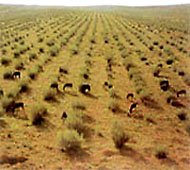 A ceremony held in Beijing will mark the beginning of the fourth phase of the 23-year long project designed to intensify the fight against ever-increasing desertification caused by advancing sand dunes.
A ceremony held in Beijing will mark the beginning of the fourth phase of the 23-year long project designed to intensify the fight against ever-increasing desertification caused by advancing sand dunes.
The "Green Great Wall" was envisioned in 1978 and was designed to be completed in three stages with a total of eight phases.
By the end of 2000, three phases of the barrier forests had been completed with an investment of 3.6 billion yuan (US$433 million), resulting in more than 27.8 million hectares of forests.
Over the next 10 years, 9.5 million hectares of forests are expected to be afforested in 13 municipalities, provinces and autonomous regions in the northern, northwestern and northeastern parts of China.
Under the fourth phase, more than 6.3 million hectares or 66 percent of the total will be planted with manpower, 1.2 million hectares will be afforested by airplanes dropping seeds in remote mountainous areas and local afforestation of 1.9 million hectares will be facilitated by closing hillsides to livestock grazing and fuel gathering.
"The move is to boost a rapid and sustainable development of economy in northern, northeastern and northwestern China through rehabilitating the areas' fragile ecosystems fundamentally," Zhou Shengxian, SFA's top official, said.
Zhou was confident that the new forests will increase the net forest coverage rate in the three northern areas by 1.84 percent and improve their deteriorating eco-environments.
"It will also set up a network to monitor, protect and prevent these regions," Zhou added.
Over the next 10 years, the fourth phase of the afforestation effort is expected to bring desertification under control in 40 percent of the areas affected in these regions.
In areas prone to soil erosion, the project is estimated to curb erosion in over 50 percent of the stricken lands, cutting land affected by erosion by 30 percent.
In farming plains, a shelter belt consisting of clumps of arbors, shrubs and herbaceous plants will be established to protect well-cultivated lands.
An official with the SFA said: "The State will be responsible for the investment of the massive afforestation with millions of farmers to be encouraged to plant trees."
More advanced technology, including the use of aeroplanes to drop seeds, remote sensing and global positioning systems, will also be adopted to ensure the highest possible survival rate of planted trees.
In the following years, the State will continue to earmark funds for the massive afforestation and place management of the funds under strict supervision, said Liu Jiang, deputy-director of the State Development Planning Commission.
Shielding 4 million square kilometers or 42 percent of China's total territory, the shelter belt project will be introduced in 551 counties in 13 northern provinces and autonomous regions plagued by encroaching sand dunes.
The three northern regions have a total of 1.58 million square kilometers of areas with fragile ecosystems, including eight major deserts, four key desert encroached areas and a vast expanse of Gobi.
Aggravated by poor water supply and soil erosion, desertification is one of China's most threatening environmental issues.
Some 2.622 million square kilometers in China are covered by desert, occupying 27.3 percent of the country's total land territory, official statistics indicate.
Annual direct economic losses caused by desertification total 54 billion yuan (US$6.52 billion).
And the problem is not getting better. Persistent droughts and human activities, such as overlogging, overfarming and overgrazing, contribute to a loss of 2,460 square kilometers of land to desert each year.
It will take 73 years for China to complete the afforestation project and build an effective shelter belt in northern regions.
From 1978 to 2050, a total of 35.6 million hectares of land are planned to be afforested, bringing the average woodland cover to 15 percent, up from the present 7 percent.
To date the shelter belt has succeeded in protecting over 60 percent of China's more than 133 million hectares of cultivated land, preventing them from being ravaged or damaged by moving sand dunes.
By 2050, experts believe, all reclaimable desertified land will have been brought under basic control, and co-ordinated economic, social and ecological development will prevail in areas currently afflicted by desertification.
(China Daily November 26, 2001)
